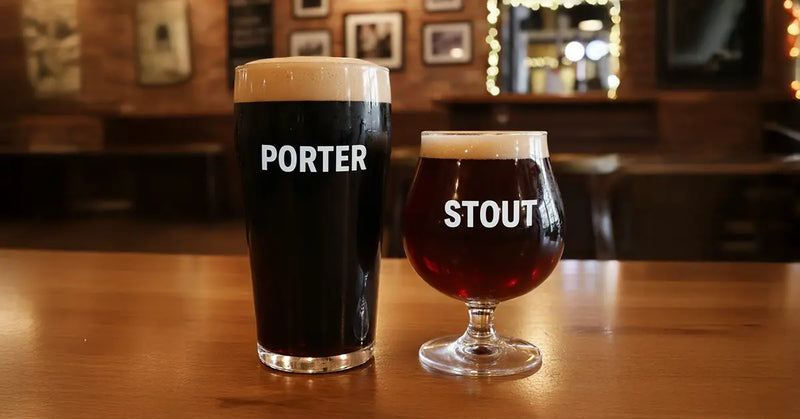
The beer world is constantly evolving, with countless styles and varieties that can leave even the biggest beer lovers spinning. Yet, the classics always hold their place at the top. Today, let’s dive into two dark beer legends, Porter and Stout. Ever wondered if they’re basically the same thing? You’re not alone! These rich, mysterious brews have been puzzling beer enthusiasts for generations.
Well, they look similar, they taste similar, and honestly, even beer experts can't always agree on what makes them different. But don’t worry, fellow beer enthusiasts! We're about to dive into the deliciously murky world of porters and stouts, where history meets hops and confusion meets clarity (kind of). Grab a pint and let's settle this age-old debate once and for all!
What is Porter?
Porter is a dark beer style that first appeared in London in the early 18th century. With a moderate alcohol concentration of 4% to 6% ABV, this rich, robust brew usually has flavours of chocolate, coffee, toffee, and caramel. Roasted malts give the beer an attractive dark brown to black hue, but it often has a lighter body than stouts. Porters are quite approachable for both newbie and expert craft beer drinkers due to their well-balanced character and mild to moderate bitterness. The medium carbonation and smooth, slightly sweet aftertaste make for a complex and satisfying drinking experience.
What is Stout?
Porter gave rise to stout, a dark beer marked by its more robust body and robust roasted flavours. Originally referred to as "stout porter" (a stronger porter), stouts usually have an alcohol content of 5% to 8%, while certain imperial varieties have much higher levels. These beers feature strong notes of burnt toast, espresso, dark chocolate, and occasionally even smoke. Stouts get their jet-black colour and creamy texture from the addition of highly roasted malts and frequently unmalted roasted barley. Compared to porter, it has a considerably thicker texture and a strong, roasted bitterness that clings to the tongue.
Types of Porter
Robust Porter: The most traditional style with assertive roasted malt character, moderate bitterness, and chocolate or coffee notes.
Baltic Porter: A stronger, lager-fermented version (7-10% ABV) with smooth, vinous qualities and complex malt sweetness.
Brown Porter: Lighter in body and roast intensity, featuring more caramel and nutty flavors with gentle chocolate undertones.
Smoked Porter: Incorporates smoked malts for a distinctive campfire or bacon-like character alongside traditional porter flavors.
Types of Stout
Dry Irish Stout: Crisp, roasty, and highly drinkable with a dry finish (think Guinness), usually around 4-5% ABV.
Sweet/Milk Stout: Contains lactose for a creamy, sweet character with lower bitterness and dessert-like qualities.
Imperial/Russian Imperial Stout: Bold, high-alcohol versions (8-12%+ ABV) with intense flavors and warming alcohol presence.
Oatmeal Stout: Brewed with oats for extra smoothness and a silky mouthfeel with nutty undertones.
Coffee/Chocolate Stout: Infused with actual coffee or chocolate for amplified flavors beyond what malts provide alone.
Malted vs Unmalted Barley: The Secret Ingredient
One key technical difference between many porters and stouts lies in their grain bill. Porters traditionally use malted barley that's been roasted to varying degrees, creating chocolate and caramel flavors. Stouts, particularly Irish stouts, often incorporate unmalted roasted barley alongside malted grains.
What unmalted barley brings to stouts:
-
Sharper, more astringent roasted character
-
Drier, crisper finish with coffee-like bitterness.
-
Darker, more opaque appearance
-
Enhanced head retention and creamier foam
While modern brewing has blurred these distinctions, the use of unmalted barley remains a hallmark of traditional stout production.
Porter vs Stout: Quick Comparison
Here’s a quick breakdown of what sets these dark brews apart. They might look alike, but there’s more to Porter and Stout than just their deep, dark colour.
|
Body |
Medium |
Full to heavy |
|
Color |
Dark brown to black |
Jet black |
|
ABV |
4-6% (typically) |
5-8%+ (typically) |
|
Roast Intensity |
Moderate |
High |
|
Bitterness |
Balanced |
More pronounced |
|
Flavour Profile |
Chocolate, caramel, toffee |
Coffee, dark chocolate, burnt toast |
|
Mouthfeel |
Smooth, lighter |
Creamy, thicker |
|
Origin |
Came first (1700s) |
Evolved from porter (1800s) |
History and Origin of Porter
Porter emerged in London around 1722, becoming the first beer style brewed on an industrial scale. The name allegedly comes from its popularity among street and river porters (manual laborers) who needed an affordable, hearty beverage. Brewers created porter by aging and blending different beers, producing a dark, flavorful ale that was more stable than previous styles. By the mid-1800s, porter dominated the British beer market and spread internationally. However, production declined dramatically in the 20th century as pale lagers gained popularity. The craft beer revolution of the 1970s-80s revived porter, with American brewers reinterpreting the style with bolder hop profiles and innovative ingredients.
History and Origin of Stout
In the late 1700s, the term "stout porter" emerged to refer to a stronger, more robust form of porter. At first, "stout" appeared as an adjective to describe any strong beer rather than a particular type. Irish brewers like Guinness started focusing on these stronger porters by the early 1800s, eventually removing the word "porter" from the name entirely. When compared to English porters, Irish stouts have a noticeably drier character due to the frequent addition of unmalted roasted barley. When British brewers produced extra-strong versions to ship to the Russian imperial court, imperial stouts were born. Centuries of creativity and regional expression are reflected in the extensive Stout family of today.
FAQs
Q: Which is stronger, porter or stout?
Stouts typically have a slightly higher alcohol content (5-8%+ ABV) than porters (4-6% ABV), though there are exceptions to this and crossover in both beer styles.
Q: Is Guinness a porter or stout?
Guinness is a dry Irish stout, even though it's lighter-bodied than many craft stouts. It's one of the world's most famous stout varieties that’s an all-time favourite among stout lovers.
Q: Can beginners drink porter and stout?
Of course! Before trying with more potent dark beers, start with a milk stout or brown porter for a softer, sweeter approach.
Q: Are porters and stouts always dark?
Indeed, roasted malts give both kinds their dark colour, though the strength varies from dark brown to totally jet black.
Q: Do dark beers have more calories?
Not always! Calories are determined by alcohol concentration and residual sugars, not colour. Compared to darker styles, some light-coloured beers contain more calories.
So, what's the real difference between porter and stout? Honestly, it's complicated, and that's what makes these dark beers so fascinating! Although stouts often have a richer flavour and more roasted punch, the differences have become much more hazy over centuries of brewing innovation. With brewers creating experimental varieties that defy typical classification, the craft beer industry has further erased the boundaries.
Here’s the dark yet delightful truth: whether you’re team Porter or team Stout, you’re really just team “delicious dark beer.” Want to truly understand the difference? Order both beers online and taste them side by side! Your palate will discover something new and delicious, giving you the perfect comeback the next time this debate comes up at the bar with your beer mates. Cheers to the dark side!
